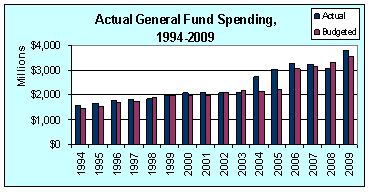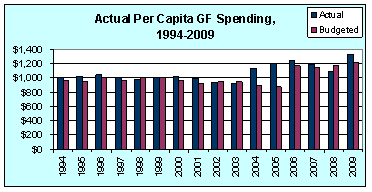The one-way bet
State budgeting process: Heads they win, tails you lose
- Wednesday, May 20, 2009
Ever made a dream list of all the things you'd like to have?
Politicians do this all the time. Unlike the rest of us, however, they then proceed to buy everything on their list — with our money.
One way they get away with it is by wielding a boring and dry-sounding accounting term that puts normal people to sleep: "baseline budgeting." When they utter it, people think the politicians are watching spending — when they're actually increasing it.
Nevada state government budgets its finances this way every two years. The very first number computed is the amount of money that the Executive Branch would like to spend over the coming biennium. Specifically, the Department of Administration first sets the "baseline" by determining how much it will cost to continue the existing level of government operations over the next two years. This number increases substantially from one biennium to the next because it builds in so-called "roll-up" costs, such as caseload increases, higher agency assessments and, perhaps most significantly, annual employee pay raises.
This "baseline budgeting" method can be extremely inefficient, because it fails to regularly reexamine the usefulness of existing state programs. "Zero-based budgeting," on the other hand — requiring the Executive Branch to build its budget from scratch each biennium by weighing priorities and evaluating the effectiveness of existing programs — could mean significant cost savings for Nevada taxpayers.
Once the baseline is calculated, the Department of Administration adds in the cost of new programs the Executive Branch would like. Only after the final "dream list" of proposed spending is calculated is there any consideration of what state revenues might be over the biennium.
Since the early 1990s, Nevada has derived its revenue projections from its Economic Forum process, which produces a preliminary estimate in December, before the legislature meets. This budgeting method amounts to a one-way bet for state government. If the Economic Forum's revenue projections are lower than the spending "dream list," then government officials have cover for increasing taxes. If revenue projections exceed the cost of the "dream list," government officials are able to add in even more spending.
Hence, government officials and their bureaucratic underlings can only "win" and not lose. Conversely, taxpayers can only lose and not win.
In fact, taxpayers are doubly exploited because government officials play the one-way bet not only with projected revenues, but with actual revenues as well. Historically, when actual revenues have exceeded the budgeted projections, government officials have proceeded to spend that additional revenue with haste. Actual General Fund spending has regularly exceeded the budgeted amounts over the past 15 years. When actual revenues have come in slightly under projections (such as in 2003), this has resulted in further calls for higher taxes because the "dream list" was not entirely funded.


*Inflation-adjusted spending levels. Source: NV Department of Administration.
Since 1994, Nevada state government has spent close to $2 billion that was never approved by the full legislative body, but rather by the Interim Finance Committee - a handful of legislators who meet between legislative sessions. In FY05 alone, state government spent nearly $800 million in excess of approved spending amounts. In the current fiscal year, state government will spend $100 more per person than citizens have been led to believe.
There are serious questions as to whether this extra-budgetary spending is even legal. Citizens of Nevada elect 63 representatives to the state legislature to act as the legitimate stewards of taxpayer money. Supposedly, the full legislative body has to approve all government expenditures. Yet, this has not happened. Significantly, the figures for actual spending amounts are not readily available in any known government documents and many citizens are doubtless unaware that they regularly exceed the budgeted amounts. These figures were provided to the Nevada Policy Research Institute as a result of a specifically worded open-records request.
These figures further reveal that the supposed "cuts" to spending made by legislators in the 2007-09 biennium have been overstated significantly. In fact, the figures show that General Fund spending over this biennium is projected to exceed the budgeted amount once again. Many of the supposed "cuts" have not included spending cuts at all, but instead were a series of loans and fund sweeps that allowed lawmakers to prop up spending.
Now, lawmakers are once again trying to chain a heavier burden to the citizens of Nevada. However, this is being done under false pretenses as state officials have regularly misrepresented the amount of money they have already spent. Now is the time for real reform of the budgetary process.
To protect the interests of the state's citizens, the one-way bet must be eliminated and a zero-based budgeting system should be implemented. That budget should be based on revenues and not "dream list" expenditures. Finally, state officials should be upfront about the amount of money they are spending and the legislature should better perform its job of controlling the purse.
Geoffrey Lawrence is a fiscal policy analyst at the Nevada Policy Research Institute.





